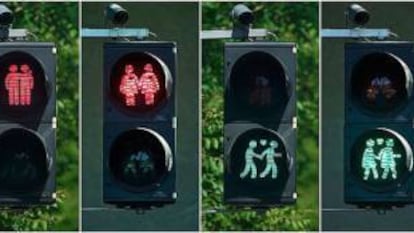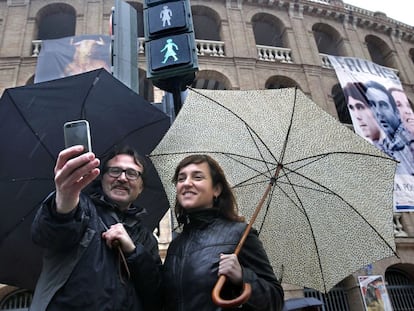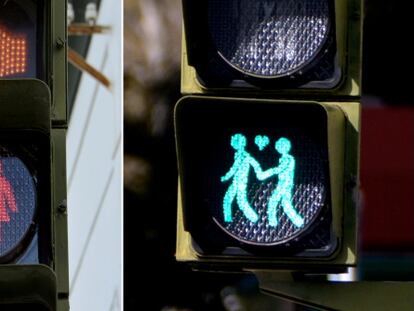Ahead of Gay Pride, Madrid introduces same-sex traffic lights
Officials want them to become a new symbol for the city and an acknowledgement of its diversity
Madrid has a new symbol. On Monday, city officials inaugurated pedestrian traffic lights depicting women and same-sex couples. “Madrid needed to have this acknowledgment on its streets,” said Mayor Manuela Carmena. “Traffic lights are intended to take care of citizens, and they had to reflect the city’s diversity.”

A total of 288 new lights will go up at 72 intersections across the Spanish capital, at a cost of €21,747.
The move builds on an earlier initiative in the Andalusian city of San Fernando de Cádiz, which put up its own same-sex traffic lights in February of this year. And in March 2016, Valencia introduced female characters on some of the lights regulating its pedestrian crossings.
When I saw the new lights, it made me think of Berlin
Toni Poveda, Gay Pride coordinator
Madrid Mayor Carmena said it was important for the city to recognize its own diversity through lights depicting “children, men, women and couples, instead of individuals.” Carmena and a contingent of councilors from the ruling leftist Ahora Madrid coalition personally surveyed the new lights during a tour of the city center.
The full installation will not be completed until June 26. “We are going to act progressively in order to reach all the districts,” said Inés Sabanés, a city official in charge of environmental and mobility affairs. “Through this action, and in partnership with social groups and parties, we are creating a symbolic element that conveys a message of diversity, which is a symbol of our capital,” she said.
There are also plans to introduce crosswalks with stripes painted in the colors of the rainbow flag, said Jesús Generelo, president of the Spanish Federation of LGTB Collectives (FELGTB).
Other cities

In 2015, Vienna installed 47 traffic lights depicting gay and straight couples to illustrate the Austrian capital's tolerant attitude in a year when it was organizing the Eurovision song competition. Other cities soon followed suit: Linz and Salzburg in Austria, Munich in southern Germany, and even London, which installed some in Trafalgar Square for the June 2016 Gay Pride festival.
Up until last year, city agencies in Madrid – governed by the Popular Party conservatives for 24 consecutive years – had never flown the rainbow flag during the Gay Pride celebrations, which are taking place in Madrid between June 23 and July 2. This year, the Spanish capital will serve as the host for the international LGBTQ World Pride event, as well as for Euro Pride.
“It’s been 40 years since the first street demonstrations in Spain to defend the community’s rights,” said Boti Rodrigo, an activist. “Where we once used to be scared walking down the streets, we can now see ourselves represented in them. A lot of things have been achieved thanks to the activist fight, and also thanks to the political change that made this municipal government possible.”
“When I saw the new lights, it made me think of Berlin,” said Toni Poveda, the FELGTB coordinator for World Pride, alluding to Ampelmann, the East Germany-created, hat-wearing traffic light symbol that survived beyond reunification and is still seen on Berlin’s city streets.
In fact, some people in attendance at Monday’s inauguration asked whether any t-shirts, bags and magnets with the new symbol will be available, much as Ampelmann products are on sale in the German capital. “We want this to be a new icon of Madrid,” said Poveda.
English version by Susana Urra.
Tu suscripción se está usando en otro dispositivo
¿Quieres añadir otro usuario a tu suscripción?
Si continúas leyendo en este dispositivo, no se podrá leer en el otro.
FlechaTu suscripción se está usando en otro dispositivo y solo puedes acceder a EL PAÍS desde un dispositivo a la vez.
Si quieres compartir tu cuenta, cambia tu suscripción a la modalidad Premium, así podrás añadir otro usuario. Cada uno accederá con su propia cuenta de email, lo que os permitirá personalizar vuestra experiencia en EL PAÍS.
¿Tienes una suscripción de empresa? Accede aquí para contratar más cuentas.
En el caso de no saber quién está usando tu cuenta, te recomendamos cambiar tu contraseña aquí.
Si decides continuar compartiendo tu cuenta, este mensaje se mostrará en tu dispositivo y en el de la otra persona que está usando tu cuenta de forma indefinida, afectando a tu experiencia de lectura. Puedes consultar aquí los términos y condiciones de la suscripción digital.











































